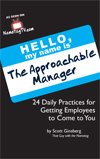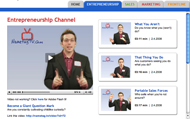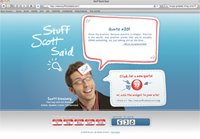 Woody Allen was wrong.
Woody Allen was wrong.
His famous one-liner was, “80% of life is showing up.”
Wrong. Showing up isn’t enough.
Think about it: How many times have YOU showed up … and sucked?
HERE’S THE REALITY: That you show up isn’t nearly as important as how you show up.
People respond to the sum total of what you present to them. Either positively, negatively, or not at all. It all depends on how you show up.
The problem is, people often shrink from showing UP because they’re terrified of being accused of showing OFF.
This doesn’t have to be the case. You can still show up strongly without showing off annoyingly.
Let’s explore seven strategies for doing so:
1. Stop proving yourself and start expressing yourself. This is a hard and humbling shift to make in your behavior. Took me about five years. And looking back, I now realize there are a few steps that can be taken by anyone to do so:
FIRST: Stop proclaiming and start displaying. Create avenues for others to experience your unique talents.
SECOND: Stop demanding your rights and start deploying your gifts. An attitude of entitlement doesn’t look good on anyone.
THIRD: Stop trying to be somebody. Befriend who you already are. It’s a lot less work.
Ultimately, these practices will enable you to inspire people from the inside, as opposed to advising them from the outside. Remember: The less you have to prove, the less other people will feel threatened around you.
Do this, and you will show up stronger than ever. What does your presence awaken in people?
2. Forego the fear of being found out. If you’re at war with yourself, you will not show up well. And the body count will double every time you walk into a room. Instead, your mission is to preserve an attitude of self-acceptance. To occupy your vulnerability and make friends with all aspects of yourself – even the ones that make you cringe.
That’s what I’ve discovered after 3,278 consecutive days of wearing a nametag: When you relax and assume everything is perfect, you begin to feel rightness and complete appropriateness in who you are. And so do the people you meet.
Do this, and you will show up stronger than ever. Are you AT war with yourself or IN love with yourself?
3. Assemble initiative, not inertia. That means being willing to be heard. That means being twice as proactive in everything you do. And that means being diligent in putting yourself in the success moment, and doing so with deadening regularity.
The enemy of initiative, on the other hand, is being paralyzed by your own mistakes. Being distracted by your own nonsense. And becoming a prisoner of yesterday’s errors. Be careful. Inertia is the slaughterer of success. Only movement counts.
Do this, and you will show up stronger than ever. Are you a cause or an effect?
4. Learn to become a part of every place you enter. In the fantastic book, Honoring the Self, I learned: “Come soft and bright as a sponge to be filled, unresisting; and allow nothing to weigh too much within your soul.”
That’s definition of vulnerability. That’s the epitome of openness. And if you practice this, and you will be welcomed everywhere you go. You will feel at home wherever you go.
Do this, and you will show up stronger than ever. When you walk into a room, how does it change?
5. Learn to become someone when you’re alone. That way, should you find yourself suddenly kicked to the curb (by your job, friends, spouse, partner, whatever), you can still prosper. As long as you listen deeply TO yourself, stay in constant rapport WITH yourself and heed what you hear FROM yourself.
That’s why I love yoga. It’s rock-solid practice trusting your support system of inner resources. Plus, you learn to “take your practice off the mat,” which is the process of transporting what you learned from one discipline into various other life containers.
As Emerson wrote in Self-Reliance, “The great man is he who in the midst of the crowd keeps with perfect sweetness the independence of solitude.” And ultimately, becoming someone when you’re alone makes it easier to show up AS someone when you’re not.
Do this, and you will show up stronger than ever. How often do you hold daily appointments with yourself?
6. Build a better you. Mousetraps are overrated. YOU are the only product that ever matters. After all, people buy people first. My suggestion is that you rededicate yourself as an instrument, recenter yourself in your commitment and recreate situations where your gifts can flourish.
That’s how you become the person you most admire. By creating a vision of how you would like yourself to be, “trying on” that vision until it fits like a glove, and then making sure lots of key people are watching you wear it.
Do this, and you will show up stronger than ever. In what area(s) of your life are you most motivated to improve?
7. Don’t just DO differently – BE differently. Here’s how: First, choose to approach the world as one giant banquet. Second, regard every moment as a new, positive opportunity to exercise your choice about how to experience life. And third, live like it’s nobody’s business.
That’s what it takes to BE (not just DO) differently. Sadly, most people aren’t ready for different. They get scared when they meet different. And you have to learn to be OK with that. You have to learn to soar in spite of that. So, remember what my Grandpa says, “Do the best you can with as many as you can.”
Do this, and you will show up stronger than ever. Do you have the courage to be unpopular?
REMEMBER: That you show up is eclipsed by the importance of HOW you show up.
Don’t shrink from doing so for fear of being accused of showing off.
Sculpt yourself into the person you want to present to others.
LET ME ASK YA THIS…
How do you show up?
LET ME SUGGEST THIS…
For the list called, “37 Personal Leadership Questions Guaranteed to Shake Your Soul,” send an email to me, and you win the list for free!
* * * *
Scott Ginsberg
That Guy with the Nametag
Author, Speaker, Coach, Entrepreneur
[email protected]
 If they can’t come UP to you; how will they ever get BEHIND you?
If they can’t come UP to you; how will they ever get BEHIND you?
Buy Scott’s new book and learn daily practices for becoming a more approachable manager!
Pick up your copy (or a case!) right here.

 • Action. That means more doing and less talking. How many times did you blog last week?
• Action. That means more doing and less talking. How many times did you blog last week?
 1. Analyze the why. Why drives you. Why is fueled by purpose. Why is what changes the world. Why is the architecture of vision. And the why is way more important than the how. Are your dreams debunked by the hopeless waiting for how?
1. Analyze the why. Why drives you. Why is fueled by purpose. Why is what changes the world. Why is the architecture of vision. And the why is way more important than the how. Are your dreams debunked by the hopeless waiting for how? I was running late to yoga class the other day.
I was running late to yoga class the other day. 
 What’s THEE best adjective to come after your name?
What’s THEE best adjective to come after your name?
 Here’s a question my readers, audience members and clients often ask me:
Here’s a question my readers, audience members and clients often ask me: If you don’t set healthy boundaries for yourself, people will set them for you.
If you don’t set healthy boundaries for yourself, people will set them for you. Who’s quoting YOU?
Who’s quoting YOU? Businesses that get talked about GET more business.
Businesses that get talked about GET more business.  You could be the greatest salesperson in the world.
You could be the greatest salesperson in the world.